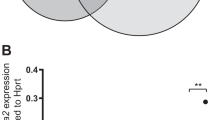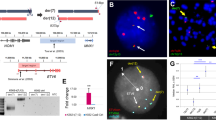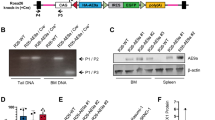Abstract
The gene encoding the transcriptional co-activator MN1 is the target of the reciprocal chromosome translocation (12;22)(p13;q12) in some patients with acute myeloid leukemia (AML). In addition, expression array analysis showed that MN1 was overexpressed in AML specified by inv(16), in some AML overexpressing ecotropic viral integration 1 site (EVI1) and in some AML without karyotypic abnormalities. Here we describe that mice receiving transplants of bone marrow (BM) overexpressing MN1 rapidly developed myeloproliferative disease (MPD). This BM also generated myeloid cell lines in culture. By mimicking the situation in human inv(16) AML, forced coexpression of MN1 and Cbfβ–SMMHC rapidly caused AML in mice. These findings identify MN1 as a highly effective hematopoietic oncogene and suggest that MN1 overexpression is an important cooperative event in human inv(16) AML.
This is a preview of subscription content, access via your institution
Access options
Subscribe to this journal
Receive 12 print issues and online access
$259.00 per year
only $21.58 per issue
Buy this article
- Purchase on Springer Link
- Instant access to full article PDF
Prices may be subject to local taxes which are calculated during checkout





Similar content being viewed by others
References
Lekanne Deprez RH, Groen NA, van Biezen NA, Hagemeijer A, van Drunen E, Koper JW et al. A t(4;22) in a meningioma points to the localization of a putative tumor-suppressor gene. Am J Hum Genet 1991; 48: 783–790.
Lekanne Deprez RH, Riegman PH, Groen NA, Warringa UL, van Biezen NA, Molijn AC et al. Cloning and characterization of MN1, a gene from chromosome 22q11, which is disrupted by a balanced translocation in a meningioma 8. Oncogene 1995; 10: 1521–1528.
Buijs A, van Rompaey L, Molijn AC, Davis JN, Vertegaal AC, Potter MD et al. The MN1-TEL fusion protein, encoded by the translocation (12;22)(p13;q11) in myeloid leukemia, is a transcription factor with transforming activity 24. Mol Cell Biol 2000; 20: 9281–9293.
van Wely KH, Molijn AC, Buijs A, Meester-Smoor MA, Aarnoudse AJ, Hellemons A et al. The MN1 oncoprotein synergizes with coactivators RAC3 and p300 in RAR-RXR-mediated transcription 5. Oncogene 2003; 22: 699–709.
Chen Z, Fisher RJ, Riggs CW, Rhim JS, Lautenberger JA . Inhibition of vascular endothelial growth factor-induced endothelial cell migration by ETS1 antisense oligonucleotides 10. Cancer Res 1997; 57: 2013–2019.
Leo C, Chen JD . The SRC family of nuclear receptor coactivators 1. Gene 2000; 245: 1–11.
Sutton AL, Zhang X, Ellison TI, Macdonald PN . The 1,25(OH)2D3-regulated transcription factor MN1 stimulates vitamin D receptor-mediated transcription and inhibits osteoblastic cell proliferation 9. Mol Endocrinol 2005; 19: 2234–2244.
Golub TR, Barker GF, Lovett M, Gilliland DG . Fusion of PDGF receptor beta to a novel ets-like gene, tel, in chronic myelomonocytic leukemia with t(5;12) chromosomal translocation 2. Cell 1994; 77: 307–316.
Chakrabarti SR, Nucifora G . The leukemia-associated gene TEL encodes a transcription repressor which associates with SMRT and mSin3A 3. Biochem Biophys Res Commun 1999; 264: 871–877.
Fenrick R, Amann JM, Lutterbach B, Wang L, Westendorf JJ, Downing JR et al. Both TEL and AML-1 contribute repression domains to the t(12;21) fusion protein 10. Mol Cell Biol 1999; 19: 6566–6574.
Lopez RG, Carron C, Oury C, Gardellin P, Bernard O, Ghysdael J . TEL is a sequence-specific transcriptional repressor 42. J Biol Chem 1999; 274: 30132–30138.
Carella C, Potter M, Bonten J, Rehg JE, Neale G, Grosveld GC . The ETS factor TEL2 is a hematopoietic oncoprotein 3. Blood 2006; 107: 1124–1132.
Kawagoe H, Grosveld GC . Conditional MN1-TEL knock-in mice develop acute myeloid leukemia in conjunction with overexpression of HOXA9 13. Blood 2005; 106: 4269–4277.
Kawagoe H, Grosveld GC . MN1-TEL myeloid oncoprotein expressed in multipotent progenitors perturbs both myeloid and lymphoid growth and causes T-lymphoid tumors in mice 13. Blood 2005; 106: 4278–4286.
Ross ME, Mahfouz R, Onciu M, Liu HC, Zhou X, Song G et al. Gene expression profiling of pediatric acute myelogenous leukemia 12. Blood 2004; 104: 3679–3687.
Valk PJ, Verhaak RG, Beijen MA, Erpelinck CA, Barjesteh van Waalwijk van Doorn-Khosrovani S, Boer JM et al. Prognostically useful gene-expression profiles in acute myeloid leukemia 16. N Engl J Med 2004; 350: 1617–1628.
Heuser M, Beutel G, Krauter J, Dohner K, von Neuhoff N, Schlegelberger B et al. High meningioma 1 (MN1) expression as a predictor for poor outcome in acute myeloid leukemia with normal cytogenetics. Blood 2006; 108: 3898–3905.
Liu PP, Hajra A, Wijmenga C, Collins FS . Molecular pathogenesis of the chromosome 16 inversion in the M4Eo subtype of acute myeloid leukemia 9. Blood 1995; 85: 2289–2302.
Otto F, Lubbert M, Stock M . Upstream and downstream targets of RUNX proteins 1. J Cell Biochem 2003; 89: 9–18.
Castilla LH, Wijmenga C, Wang Q, Stacy T, Speck NA, Eckhaus M et al. Failure of embryonic hematopoiesis and lethal hemorrhages in mouse embryos heterozygous for a knocked-in leukemia gene CBFB-MYH11 4. Cell 1996; 87: 687–696.
Okuda T, van Deursen J, Hiebert SW, Grosveld G, Downing JR . AML1, the target of multiple chromosomal translocations in human leukemia, is essential for normal fetal liver hematopoiesis. Cell 1996; 84: 321–330.
Sasaki K, Yagi H, Bronson RT, Tominaga K, Matsunashi T, Deguchi K et al. Absence of fetal liver hematopoiesis in mice deficient in transcriptional coactivator core binding factor beta 22. Proc Natl Acad Sci USA 1996; 93: 12359–12363.
Wang Q, Stacy T, Binder M, Marin-Padilla M, Sharpe AH, Speck NA . Disruption of the Cbfa2 gene causes necrosis and hemorrhaging in the central nervous system and blocks definitive hematopoiesis 8. Proc Natl Acad Sci USA 1996; 93: 3444–3449.
Castilla LH, Garrett L, Adya N, Orlic D, Dutra A, Anderson S et al. The fusion gene Cbfb-MYH11 blocks myeloid differentiation and predisposes mice to acute myelomonocytic leukaemia 2. Nat Genet 1999; 23: 144–146.
Higuchi M, O'Brien D, Kumaravelu P, Lenny N, Yeoh EJ, Downing JR . Expression of a conditional AML1-ETO oncogene bypasses embryonic lethality and establishes a murine model of human t(8;21) acute myeloid leukemia 1. Cancer Cell 2002; 1: 63–74.
Look AT . Oncogenic transcription factors in the human acute leukemias 5340. Science 1997; 278: 1059–1064.
Castilla LH, Perrat P, Martinez NJ, Landrette SF, Keys R, Oikemus S et al. Identification of genes that synergize with Cbfb-MYH11 in the pathogenesis of acute myeloid leukemia 14. Proc Natl Acad Sci USA 2004; 101: 4924–4929.
Landrette SF, Kuo YH, Hensen K, Barjesteh van Waalwijk van Doorn-Khosrovani S, Perrat PN, Van de Ven WJ et al. Plag1 and Plagl2 are oncogenes that induce acute myeloid leukemia in cooperation with Cbfb-MYH11 7. Blood 2005; 105: 2900–2907.
Cardone M, Kandilci A, Carella C, Nilsson JA, Brennan JA, Sirma S et al. The novel ETS factor TEL2 cooperates with Myc in B lymphomagenesis 6. Mol Cell Biol 2005; 25: 2395–2405.
Akashi K, Traver D, Miyamoto T, Weissman IL . A clonogenic common myeloid progenitor that gives rise to all myeloid lineages 6774. Nature 2000; 404: 193–197.
Stanley KK, Szewczuk E . Multiplexed tandem PCR: gene profiling from small amounts of RNA using SYBR Green detection 20. Nucleic Acids Res 2005; 33: e180.
Bennett JM, Catovsky D, Daniel MT, Flandrin G, Galton DA, Gralnick HR et al. Proposal for the recognition of minimally differentiated acute myeloid leukaemia (AML-MO) 3. Br J Haematol 1991; 78: 325–329.
Wijmenga C, Gregory PE, Hajra A, Schrock E, Ried T, Eils R et al. Core binding factor beta-smooth muscle myosin heavy chain chimeric protein involved in acute myeloid leukemia forms unusual nuclear rod-like structures in transformed NIH 3T3 cells. Proc Natl Acad Sci USA 1996; 93: 1630–1635.
Yanagisawa K, Horiuchi T, Fujita S . Establishment and characterization of a new human leukemia cell line derived from M4E0 2. Blood 1991; 78: 451–457.
Ayton PM, Cleary ML . Transformation of myeloid progenitors by MLL oncoproteins is dependent on Hoxa7 and Hoxa9 18. Genes Dev 2003; 17: 2298–2307.
He LZ, Bhaumik M, Tribioli C, Rego EM, Ivins S, Zelent A et al. Two critical hits for promyelocytic leukemia 5. Mol Cell 2000; 6: 1131–1141.
Largaespada DA . Genetic heterogeneity in acute myeloid leukemia: maximizing information flow from MuLV mutagenesis studies 7. Leukemia 2000; 14: 1174–1184.
Barjesteh van Waalwijk van Doorn-Khosrovani S, Spensberger D, de Knegt Y, Tang M, Lowenberg B, Delwel R . Somatic heterozygous mutations in ETV6 (TEL) and frequent absence of ETV6 protein in acute myeloid leukemia 25. Oncogene 2005; 24: 4129–4137.
Du Y, Jenkins NA, Copeland NG . Insertional mutagenesis identifies genes that promote the immortalization of primary bone marrow progenitor cells. Blood 2005; 106: 3932–3939.
Meester-Smoor MA, Vermeij M, van Helmond MJ, Molijn AC, van Wely KH, Hekman AC et al. Targeted disruption of the Mn1 oncogene results in severe defects in development of membranous bones of the cranial skeleton 10. Mol Cell Biol 2005; 25: 4229–4236.
Blobel GA . CREB-binding protein and p300: molecular integrators of hematopoietic transcription. Blood 2000; 95: 745–755.
Chen CR, Kang Y, Massague J . Defective repression of c-myc in breast cancer cells: A loss at the core of the transforming growth factor beta growth arrest program 3. Proc Natl Acad Sci USA 2001; 98: 992–999.
Kang Y, Chen CR, Massague J . A self-enabling TGFbeta response coupled to stress signaling: Smad engages stress response factor ATF3 for Id1 repression in epithelial cells 4. Mol Cell 2003; 11: 915–926.
Kuo YH, Landrette SF, Heilman SA, Perrat PN, Garrett L, Liu PP et al. Cbf beta-SMMHC induces distinct abnormal myeloid progenitors able to develop acute myeloid leukemia 1. Cancer Cell 2006; 9: 57–68.
Grisendi S, Pandolfi PP . NPM mutations in acute myelogenous leukemia 3. N Engl J Med 2005; 352: 291–292.
den Besten W, Kuo ML, Williams RT, Sherr CJ . Myeloid leukemia-associated nucleophosmin mutants Perturb p53-dependent and independent activities of the Arf tumor suppressor protein 11. Cell Cycle 2005; 4: 1593–1598.
Acknowledgements
We thank Dr Jerold Rehg for the pathological analysis of the mice, Dr Richard Ashmun and Ann-Mary Hamilton Easton for expert FACS analysis and Blake McGourty for the supply of C57Bl/6/129svJ mixed-background mice. This work was supported by NCI Grant CA72999, the Cancer Center (CORE) support grant CA021765, the Dutch Cancer Society Grants EUR98-1778 and DDHK2003-2869, the Intramural Research Programs of NHGRI, NIH and by the American Lebanese Syrian Associated Charities (ALSAC).
Author information
Authors and Affiliations
Corresponding author
Additional information
Supplementary information accompanies the paper on the Leukemia Web site (http://www.nature.com/leu)
Supplementary information
Rights and permissions
About this article
Cite this article
Carella, C., Bonten, J., Sirma, S. et al. MN1 overexpression is an important step in the development of inv(16) AML. Leukemia 21, 1679–1690 (2007). https://doi.org/10.1038/sj.leu.2404778
Received:
Accepted:
Published:
Issue Date:
DOI: https://doi.org/10.1038/sj.leu.2404778
Keywords
This article is cited by
-
Menin is necessary for long term maintenance of meningioma-1 driven leukemia
Leukemia (2021)
-
Ectopia associated MN1 fusions and aberrant activation in myeloid neoplasms with t(12;22)(p13;q12)
Cancer Gene Therapy (2020)
-
Effective drug treatment identified by in vivo screening in a transplantable patient-derived xenograft model of chronic myelomonocytic leukemia
Leukemia (2020)
-
The clinical mutatome of core binding factor leukemia
Leukemia (2020)
-
Novel strategy for rapid functional in vivo validation of oncogenic drivers in haematological malignancies
Scientific Reports (2019)



